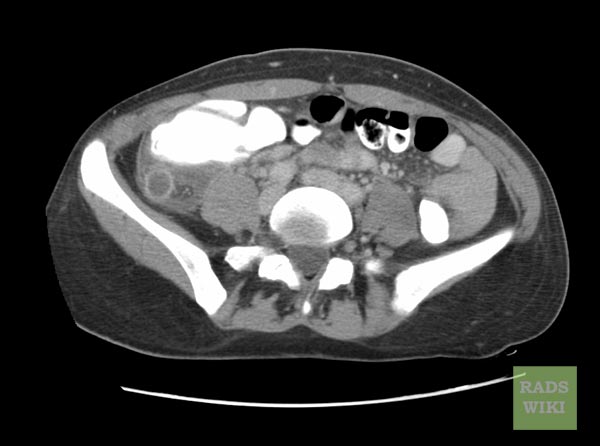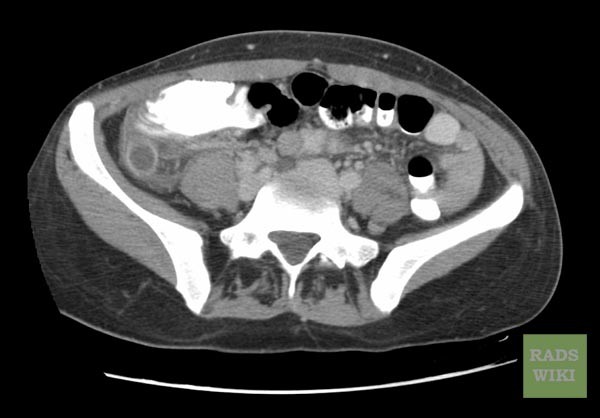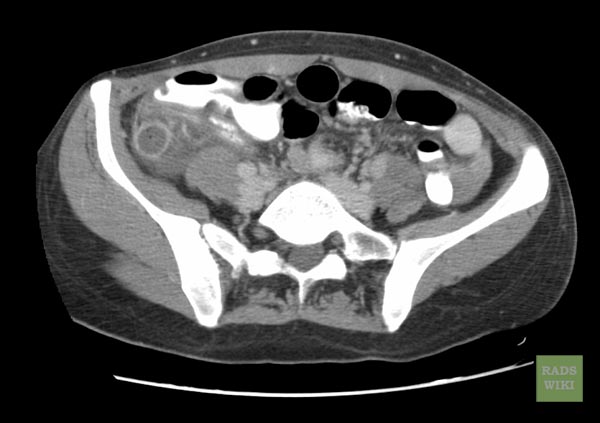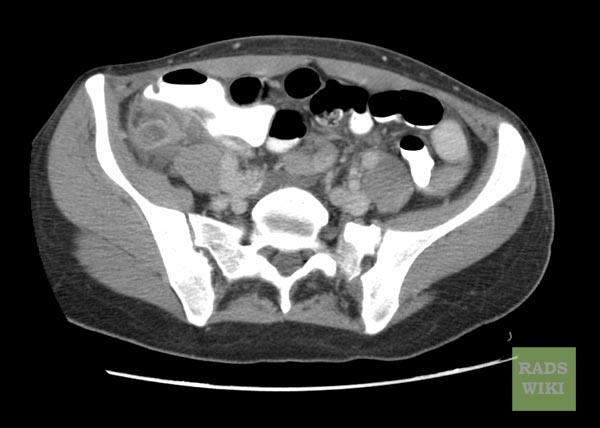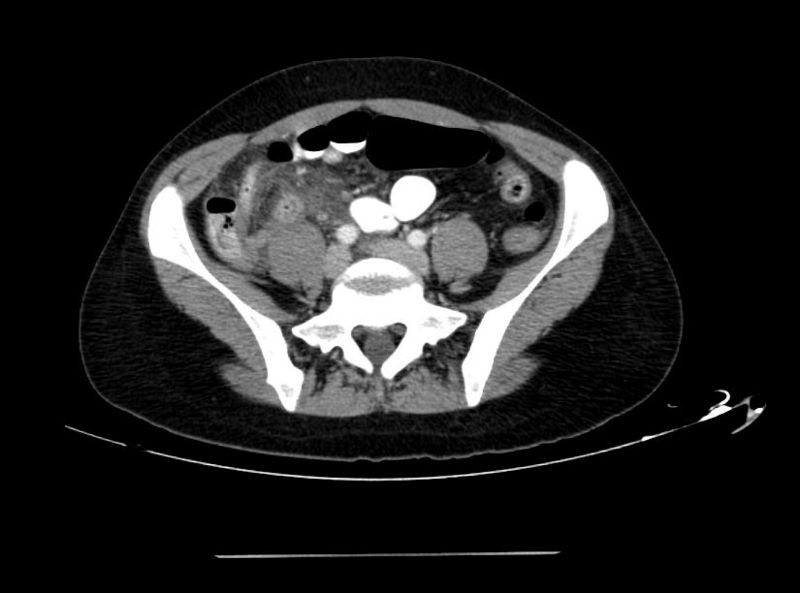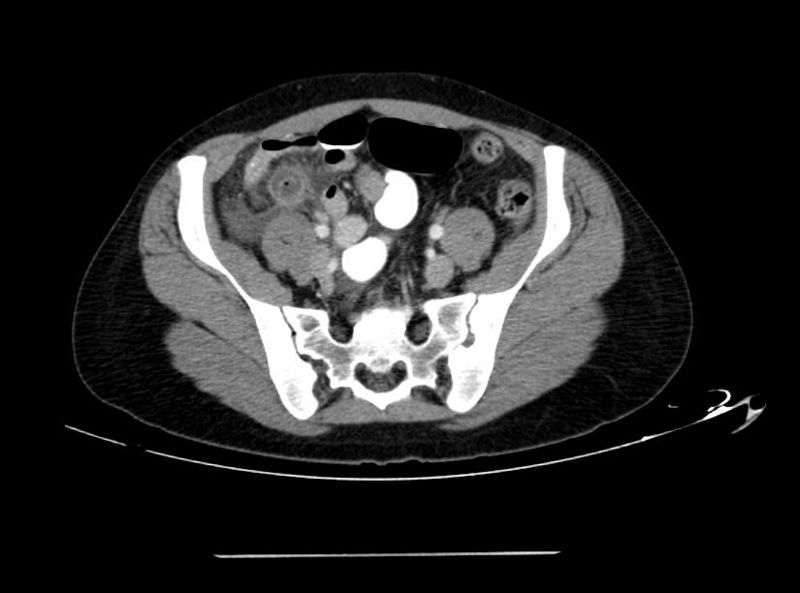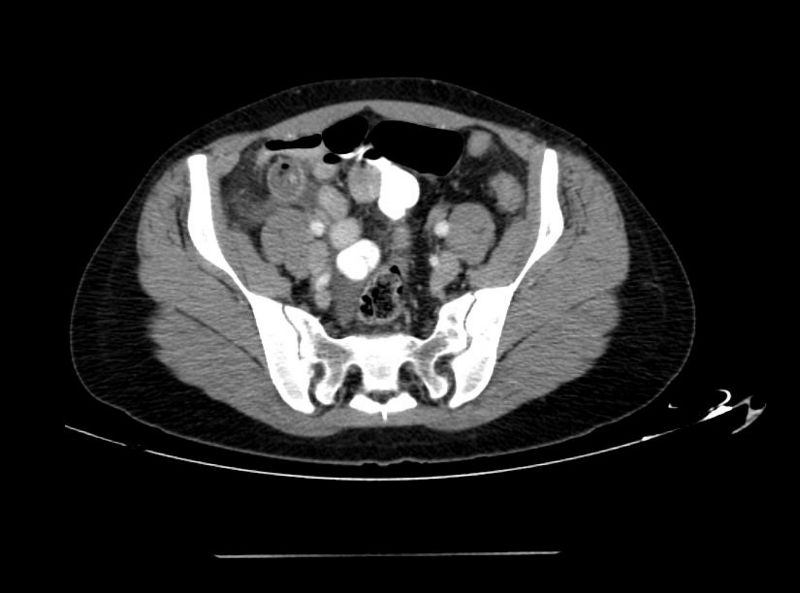Appendicitis
Template:DiseaseDisorder infobox
|
Appendicitis Microchapters |
|
Diagnosis |
|---|
|
Treatment |
|
Case Studies |
|
Appendicitis On the Web |
|
American Roentgen Ray Society Images of Appendicitis |
For patient information click here
Editor-In-Chief: C. Michael Gibson, M.S., M.D. [1]
Synonyms and keywords: Epityphlitis
Overview
Historical Perspective
Classification
Pathophysiology
Causes
Differentiating Appendicitis from other Diseases
Epidemiology and Demographics
Natural History, Complications, and Prognosis
Diagnosis
Investigations
Diagnosis is based on patient history (symptoms) and physical examination backed by an elevation of neutrophilic white cells. Atypical histories often requires ultrasound and/or CT scanning (Hobler, K., 1998).
Ultrasonography and Doppler sonography provide useful means to detect appendicitis, especially in children. In some cases (15% approximately), however, ultrasonography of the iliac fossa does not reveal any abnormalities despite the presence of appendicitis. This is especially true of early appendicitis before the appendix has become significantly distended and in adults where larger amounts of fat and bowel gas make actually seeing the appendix technically difficult. Despite these limitations, in experienced hands sonographic imaging can often distinguish between appendicitis and other diseases with very similar symptoms such as inflammation of lymph nodes near the appendix or pain originating from other pelvic organs such as the ovaries or fallopian tubes.
In places where it is readily available, CT scan has become the diagnostic test of choice, especially in adults whose diagnosis is not obvious on history and physical. (The use of CT in pregnant women and children is significantly limited, however, by concerns regarding radiation exposure.) A properly performed CT scan with modern equipment has a detection rate (sensitivity) of over 95% and a similar specificity. Signs of appendicitis on CT scan include lack of contrast (oral dye) in the appendix and direct visualization of appendiceal enlargement (greater than 6 mm in diameter on cross section). The inflammation caused by appendicitis in the surrounding peritoneal fat (so called "fat stranding") can also be observed on CT, providing a mechanism to detect early appendicitis and a clue that appendicitis may be present even when the appendix is not well seen. Thus, diagnosis of appendicitis by CT is made more difficult in very thin patients and in children, both of whom tend to lack significant fat within the abdomen. The utility of CT scanning is made clear, however, by the impact it has had on negative appendectomy rates. For example, use of CT for diagnosis of appendicitis in Boston, MA has decreased the chance of finding a normal appendix at surgery from 20% in the pre-CT era to only 3% according to data from the Massachusetts General Hospital.
According to a systematic review from UC-San Francisco comparing ultrasound vs. CT scan, CT scan is more accurate than ultrasound for the diagnosis of appendicitis in adults and adolescents. CT scan has a sensitivity of 94%, specificity of 95%, a positive likelihood ratio of 13.3 (CI, 9.9 to 17.9), and a negative likelihood ratio of 0.09 (CI, 0.07 to 0.12). Ultrasonography had an overall sensitivity of 86%, a specificity of 81%, a positive likelihood ratio of 5.8 (CI, 3.5 to 9.5), and a negative likelihood ratio of 0.19 (CI, 0.13 to 0.27). PMID 15466771
A number of clinical and laboratory based scoring systems have been devised to assist diagnosis. The most widely used is Alvarado score.
Alvarado score
Symptoms:
- migratory right iliac fossa pain, 1 point
- anorexia, 1 point
- nausea and vomiting, 1 point
Signs:
- right iliac fossa tenderness, 2 points
- rebound tenderness, 1 point
- fever, 1 point
Laboratory:
- leucocytosis, 2 points
- shift to left( segmented neutrophils), 1 point
Total score = 10.
A score of 7 or more is strongly predictive of acute appendicitis.
In patients with an equivocal score of 5-6, CT scan further reduces the rate of negative appendicectomy.
CT
- Appendiceal thickening with the outer-wall-to-outer-wall transverse diameter greater than 6 mm.
- Some authors define appendiceal thickening on CT as transverse diameter greater than 7 mm
- The appendiceal diameter probably should be interpreted in the context of clinical and other
- Appendiceal wall thickening (wall ≥ 3mm)
- Appendiceal wall hyperenhancement
- Mural stratification of the appendiceal wall
- Appendicolith(s) (present in one third of patients with appendicitis).
- Cecal apical thickening (diffuse as opposed to apical cecal thickening is also possible, but this is less specific for appendicitis).
- Periappendiceal inflammation includes periappendiceal fat stranding, thickening of the lateral conal fascia, and mesoappendix, extraluminal fluid, phlegmon, abscess, ileocecal mild lymph node enlargement, and inflammatory thickening of contiguous structures.
Patient #1: Right lower quadrant pain
Patient #2: Right lower quadrant pain
Patient #3: Right lower quadrant pain
Treatment
The treatment begins by keeping the patient from eating or drinking anything, even water, in preparation for surgery. An intravenous drip is used to hydrate the patient. Antibiotics given intravenously such as cefuroxime and metronidazole may be administered early to help kill bacteria and thus reduce the spread of infection in the abdomen and postoperative complications in the abdomen or wound. Equivocal cases may become more difficult to assess with antibiotic treatment and benefit from serieal examinations. If the stomach is empty (no food in the past six hours) general anaesthesia is usually used. Otherwise, spinal anaesthesia may be used.
The surgical procedure for the removal of the appendix is called an appendicectomy (also known as an appendectomy). Often now the operation can be performed via a laparoscopic approach, or via three small incisions with a camera to visualize the area of interest in the abdomen. If the findings reveal suppurative appendicitis with complications such as rupture, abscess, adhesions, etc., conversion to open laparotomy may be necessary. An open laparotomy incision if required most often centers on the area of maximum tenderess, McBurney's point, in the right lower quadrant. A transverse or a gridiron diagonal incision is used most commonly.
According to a meta-analysis from the Cochrane Collaboration comparing laparoscopic and open procedures, laparoscopic procedures seem to have various advantages over the open procedure. Wound infections were less likely after laparoscopic appendicectomy than after open appendicectomy (odds ratio 0.45; CI 0.35 to 0.58), but the incidence of intraabdominal abscesses was increased (odds ratio 2.48; CI 1.45 to 4.21). The duration of surgery was 12 minutes (CI 7 to 16) longer for laparoscopic procedures. Pain on day 1 after surgery was reduced after laparoscopic procedures by 9 mm (CI 5 to 13 mm) on a 100 mm visual analogue scale. Hospital stay was shortened by 1.1 day (CI 0.6 to 1.5). Return to normal activity, work, and sport occurred earlier after laparoscopic procedures than after open procedures. While the operation costs of laparoscopic procedures were significantly higher, the costs outside hospital were reduced. Young female, obese, and employed patients seem to benefit from the laparoscopic procedure more than other groups. [1]
Surgery may last from 15 minutes in typical appendicitis in thin patients to several hours in complicated cases. Hospital lengths of stay usually range from overnight to a matter of days (rarely weeks in complicated cases.) The pain is not always constant, in some cases it can stop for a day and then come back.
References
- ↑ Sauerland S, Lefering R, Neugebauer EA (2004). "Laparoscopic versus open surgery for suspected appendicitis". Cochrane Database Syst Rev (4): CD001546. doi:10.1002/14651858.CD001546.pub2. PMID 15495014.
